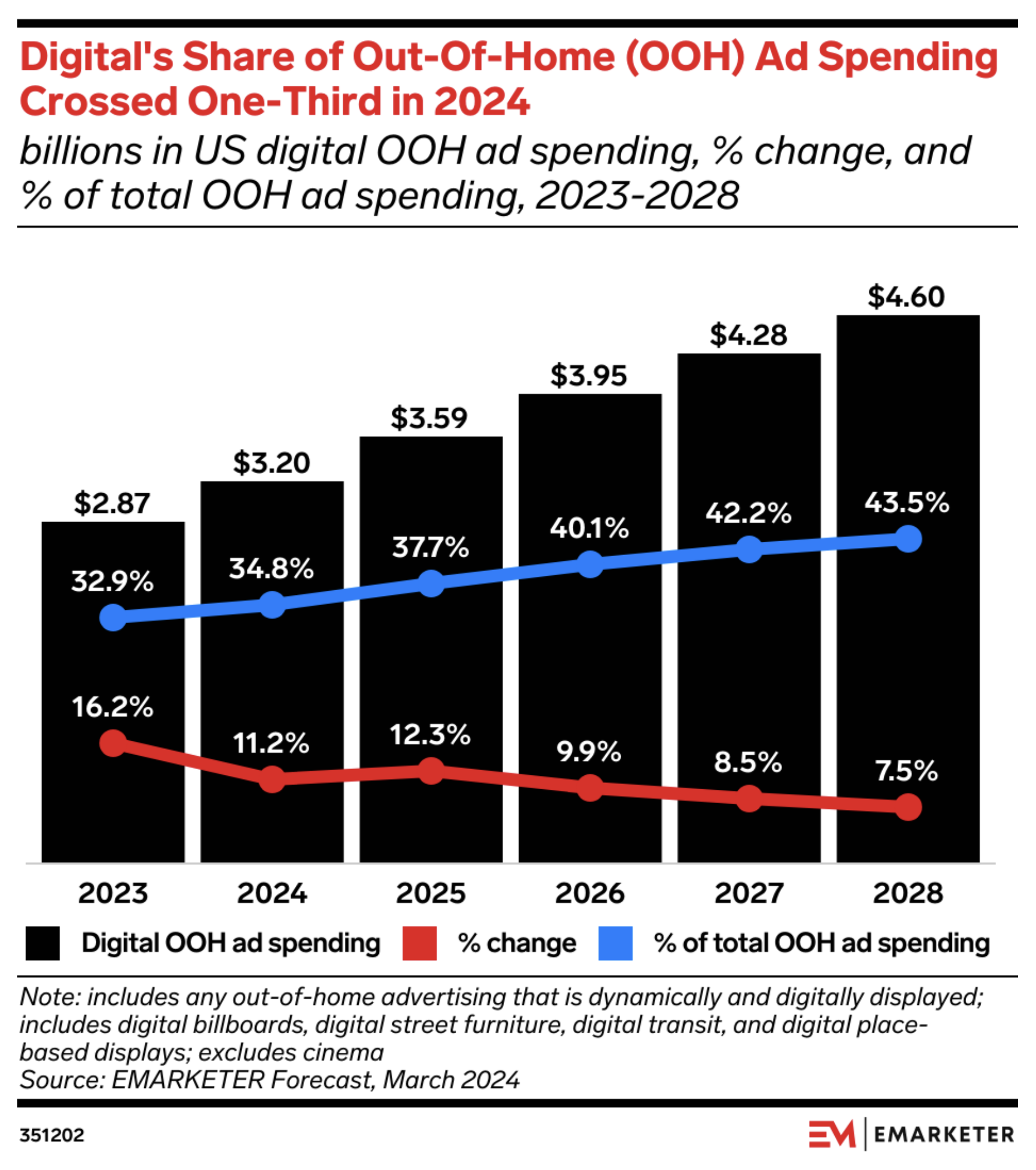The Future of Out-of-Home Advertising: Trends to Watch in 2024
OOH Trends.
Key Takeaways
Out‑of‑home (OOH) advertising spend is projected to surpass $9 billion in 2024, growing at a steady 3–5% annually while other traditional media decline; although OOH’s share of total ad spend may shrink slightly as digital formats expand, it remains a reliable channel for reaching physical‑world audiences.
Digital OOH (DOOH) is driving growth: digital billboards and screens are expected to represent over one‑third of OOH spend and programmatic DOOH will exceed a quarter of DOOH spend; DOOH offers dynamic creative and real‑time adjustments, but higher costs mean advertisers must choose high‑impact locations strategically and integrate with digital channels.
Retail media networks are emerging: in‑store ads using first‑party data and QR codes are expected to approach $1 billion by 2028, blending awareness with measurable conversions; traditional OOH formats still comprise about two‑thirds of spending and remain powerful for brand awareness, especially when enhanced with digital elements and social media amplification.
The landscape of out-of-home (OOH) advertising is evolving, and 2024 is shaping up to be a pivotal year for the industry. As digital technologies and data-driven insights become increasingly prevalent, OOH continues to buck the trend of other traditional media, showing resilience and adaptability.
OOH Ad Spend: Moderate Growth Amidst Shifts
Despite the struggles of other traditional media channels like TV advertising, radio advertising, and print, OOH ad spending is on an upward trajectory. In 2024, US OOH ad spending is expected to surpass $9 billion, marking a steady year-over-year growth rate of between 3% and 5%. This moderate yet consistent growth contrasts sharply with declining ad budgets for linear TV, radio, and print, positioning OOH as a reliable choice for brands looking to reach audiences in the physical world.
Interestingly, while OOH spending will grow, its share of total media ad spend is projected to decline slightly—falling from 2.4% in 2024 to 2.0% by 2028. The rise of connected TV (CTV) and other digital formats is pulling more dollars, but OOH's unique advantages ensure it remains an essential part of the marketing mix.
The Rise of Digital Out-of-Home (DOOH)
Digital out-of-home (DOOH) advertising is leading the growth within the OOH space. DOOH, which includes digital billboards, transit ads, and place-based screens, will account for over a third of OOH ad spending in 2024, with significant gains expected in programmatic transactions. This year marks a milestone for programmatic DOOH, which will surpass a quarter of all DOOH ad spending in the US. By 2025, programmatic channels are expected to account for over $1 billion of DOOH ad spend.
The benefits of DOOH are clear: dynamic creative capabilities, real-time adjustments, and integration with other digital media channels make DOOH a flexible and impactful choice. However, the higher cost associated with these benefits means advertisers should be strategic in using DOOH where it can make the most impact, such as high-traffic areas and locations where contextual relevance can drive engagement.
Retail Media Networks and OOH
Another major trend shaping the OOH landscape is the growing role of retail media networks (RMNs). Retailers are increasingly leveraging in-store, place-based ads to complement their media networks, capitalizing on their access to powerful first-party data. While in-store ad spending is still relatively small, it is expected to top $1 billion by 2028, representing nearly a quarter of all DOOH ad spending.
Retailers like Walmart and Target are doubling down on their in-store ad products, emphasizing attribution through QR codes and conversion tracking. This trend reflects a broader shift in OOH toward not only brand awareness but also driving measurable actions, blurring the lines between the upper funnel and performance marketing.
Traditional OOH: Stability with a Digital Boost
While the future is increasingly digital, traditional OOH formats still hold significant value. In 2024, traditional billboards and other static formats will make up about two-thirds of OOH ad spending. These formats continue to play a critical role in brand awareness campaigns, and when combined with digital elements—such as QR codes or social media amplification—they provide a powerful bridge between physical and digital engagement.
The report highlights that social campaigns are reinvigorating traditional OOH displays. Creative uses of static OOH ads, amplified by social media and influencer partnerships, are making these formats more interactive and engaging, ensuring they stay relevant in an increasingly digital world.
Key Takeaways for Advertisers
Strategic Use of DOOH: Given the higher costs associated with DOOH, advertisers should focus on locations and campaigns where the dynamic capabilities of digital screens can deliver the most value.
Embrace Omnichannel Opportunities: OOH works well with digital channels, making it a strong contender for omnichannel campaigns. Integrating OOH with mobile, social, and connected TV can amplify campaign reach and engagement.
Harness the Power of Retail Media: In-store and near-store advertising opportunities through RMNs provide a unique way to connect with shoppers at the point of decision-making. The combination of retail media and OOH is a powerful tool for brands aiming for both awareness and conversions.
OOH advertising is at an exciting juncture. With the growth of DOOH, the rise of retail media networks, and the stability of traditional formats, OOH offers brands unique opportunities to connect with audiences in meaningful, memorable ways. As we move through 2024, the key will be to leverage the strengths of both digital and traditional OOH formats, creating campaigns that blend the best of both worlds.
Insights from the T-Mobile OOH Forecast and Trends report for 2024.












